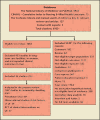Male urinary incontinence: prevalence, risk factors, and preventive interventions
- PMID: 19918340
- PMCID: PMC2777062
Male urinary incontinence: prevalence, risk factors, and preventive interventions
Abstract
Urinary incontinence (UI) in community-dwelling men affects quality of life and increases the risk of institutionalization. Observational studies and randomized, controlled trials published in English from 1990 to November 2007 on the epidemiology and prevention of UI were identified in several databases to abstract rates and adjusted odds ratios (OR) of incontinence, calculate absolute risk difference (ARD) after clinical interventions, and synthesize evidence with random-effects models. Of 1083 articles identified, 126 were eligible for analysis. Pooled prevalence of UI increased with age to 21% to 32% in elderly men. Poor general health, comorbidities, severe physical limitations, cognitive impairment, stroke (pooled OR 1.54; 95% confidence interval [CI], 1.14-2.1), urinary tract infections (pooled OR 3.49; 95% CI, 2.33-5.23), prostate diseases, and diabetes (pooled OR 1.36; 95% CI, 1.14-1.61) were associated with UI. Treatment with tolterodine alone (ARD 0.17; 95% CI, 0.02-0.32) or combined with tamsulosin (ARD 0.17; 95% CI, 0.08-0.25) resulted in greater self-reported benefit compared with placebo. Radical prostatectomy or radiotherapy for prostate cancer compared with watchful waiting increased UI. Short-term prevention of UI with pelvic floor muscle rehabilitation after prostatectomy was not consistently seen across randomized, controlled trials. The prevalence of incontinence increased with age and functional dependency. Stroke, diabetes, poor general health, radiation, and surgery for prostate cancer were associated with UI in community-dwelling men. Men reported overall benefit from drug treatments. Limited evidence of preventive effects of pelvic floor rehabilitation requires future investigation.
Keywords: Drug therapy; Rehabilitation; Risk factors; Urinary incontinence.
Figures




References
-
- Abrams P, Cardozo L, Khoury S, Wein A. Incontinence. Proceedings from the 3rd International Consultation on Incontinence. Paris: Health Publications; 2005.
-
- Anger JT, Saigal CS, Stothers L, et al. The prevalence of urinary incontinence among community dwelling men: results from the National Health and Nutrition Examination survey. J Urol. 2006;176:2103–2108. discussion 2108. - PubMed
-
- Harris SS, Link CL, Tennstedt SL, et al. Care seeking and treatment for urinary incontinence in a diverse population. J Urol. 2007;177:680–684. - PubMed
-
- Kasper DL, Harrison TR NetLibrary Inc., authors Harrison’s Principles of Internal Medicine. [Accessed November 2007]. Available at: http://www.netLibrary.com/urlapi.asp?action=summary&v=1&bookid=149871.
-
- Abrams P, Cardozo L, Khoury S, Wein AJ. Incontinence. Paris: Health Publications; 2005.
LinkOut - more resources
Full Text Sources
